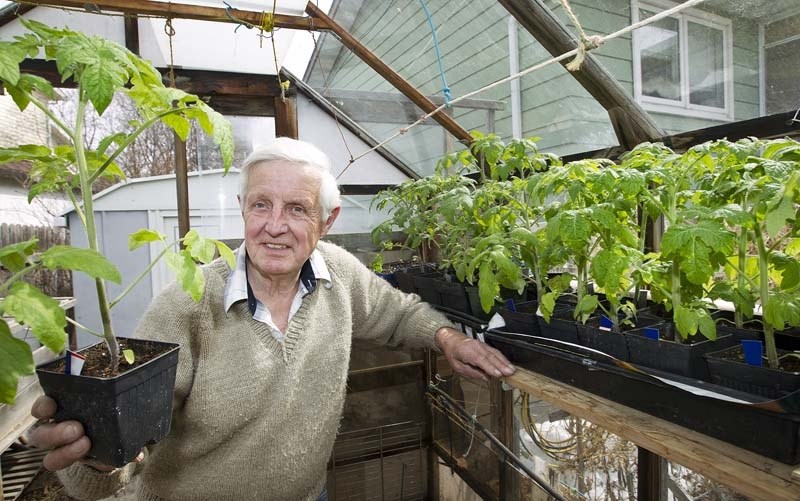Derrick Harrison hasn’t planted his own vegetable plot as yet this spring, but during his Growing an Edible Garden lecture at the St. Albert Public Library last week, he certainly seeded some inspiring gardening tips.
Harrison, who started growing vegetables in England during the Second World War, explained that he’s never lost the taste for fresh-from-the-garden food.
“Have you tasted a radish right from the ground?” Harrison asked, as he made swiping movements with an invisible radish against his trousers, to imitate cleaning the dirt off the vegetable. “You’ll never get a radish as sweet from the grocery store.”
Harrison, who is president of the St. Albert and District Garden Club, stressed that while gardening requires obvious work, there’s more to be achieved from planting a vegetable garden than simply eating the produce.
“It takes time and there is cost but if you have suitable space, with a little knowledge and experience you can grow your own food. When you are successful, there is a great sense of satisfaction and achievement. It’s also good for your health and for the environment,” Harrison said.
Even those starting a new garden can harvest a crop this year, he said.
“If you have a new space this year, you could grow root crops, like carrots, radish, beets and potatoes. You could grow leaf crops such as lettuce and you could have green fruit crops such as beans and peas. You could grow tomatoes and herbs,” he said.
The basic requirements for a successful garden cannot be ignored. To grow vegetables the garden must have good soil, adequate moisture, warmth and light.
Vegetables need the space to develop and for that reason Harrison prefers a garden plot as opposed to container gardening.
“You can grow vegetables in pots but, for example, tomatoes take more space than any other vegetable in your garden. They are hungry feeders and their roots spread out. If you grow them right in the ground you will have more fruit than if you plant them in a container,” he said.
When vegetables, like carrots and peas for example, are seeded too closely together, they need to be thinned and, in Harrison’s opinion, that’s not cost effective.
“A mistake people make is to plant the seeds too thick. Then they need to be thinned and you will likely throw away 50 to 75 per cent of your crop. If you can, plant them with enough space for the plants to grow and if you do need to thin them, it’s easier if the soil is moist,” he said.
Harrison stressed that there is no real right and wrong to gardening, and the ongoing challenge is one reason he enjoys it so much.
“Gardening doesn’t come with a computer chip that you can put in your brain and then learn. You need to follow the instructions on the seed packets and then make note of what works and what doesn’t work and learn from your mistakes,” he said.
“As a basic rule of thumb, the smaller the seed, like carrots and lettuce, then the more shallow you plant them. Larger seeds, such as peas need to be deeper.”
Harrison doesn’t like to use chemicals in his vegetable garden. He amends the soil each fall by digging in well-rotted compost and peat moss. As much as possible he keeps the garden plot clean of debris such as old plant stalks, and that helps to eliminate insect pests.
“Insects are attracted to smell. If you have old vegetable stalks in the garden, they come to that smell. I also rotate my crops to minimize pests. If the eggs are in the ground, the insects or diseases that bother one plant are away from where I’ve rotated the crop.”
He doesn’t plant cabbages or cauliflower, because it is difficult to keep moths and root grubs away from the plants.
Here’s a breakdown of what Harrison said works for him for a variety of vegetables:
• Root vegetables: Root crops need a lot of sun and moisture and good textured soil. Carrots are a bi-annual plant, which means they normally set their flowers in the second year. If they don’t have adequate moisture, the plants will set flowers in the first summer and will result in a poorer crop. To see if the soil is moist enough, stick your finger into the dirt, Harrison said.
“If the soil is not deeply cultivated, you will have short carrots. They don’t like newly manured soil,” he said.
• Potatoes: Potatoes like rich, deep, well-cultivated soil. They grow best in soil that had lots of manure added in the previous year. They do not like growing in the same spot year after year so need to be rotated to a different spot in the garden.
• Lettuce and Swiss chard: These leafy vegetables do best in loose soil. Birds and slugs love lettuce, so plant a few extra seeds. Swiss chard is a decorative plant and can also be grown in the flower garden.
• Peas and beans: Wait until the soil is warm before planting these crops, then try sowing them at intervals every few weeks to extend the crop. Stake peas to keep the pods off the ground.
• Corn: Corn grows best in soil that had a lot of manure added the year before. Corn does not like to be lonely so plant more than one row to assist with pollination.




